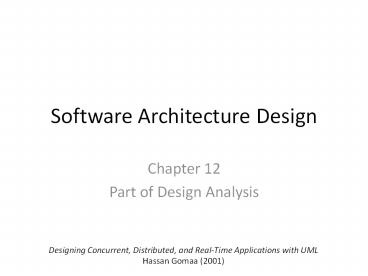Software Architecture Design - PowerPoint PPT Presentation
Title:
Software Architecture Design
Description:
Software Architecture Design Chapter 12 Part of Design Analysis Designing Concurrent, Distributed, and Real-Time Applications with UML Hassan Gomaa (2001) – PowerPoint PPT presentation
Number of Views:826
Avg rating:3.0/5.0
Title: Software Architecture Design
1
Software Architecture Design
- Chapter 12
- Part of Design Analysis
Designing Concurrent, Distributed, and Real-Time
Applications with UML Hassan Gomaa (2001)
2
Software Architecture Design
- Software Architecture refers to the decomposition
of a system into subsystems - This is necessary for large-scale and complex
software systems.
3
Software Architectural Styles
- Software Architectural styles are recurring
architectures used in a variety of applications. - Client/Server Architecture
- Layers of Abstraction Architecture
- Communicating Tasks Architecture
- The styles may be blended as necessary. They are
not mutually exclusive!
4
Client/Server Architecture
- Sever provides services
- Client consumes services
- Widely used in distributed applications.
5
Layers of Abstraction Architecture
- Each layer communicates only with the layers
directly above and below itself. - Each layer solves only part of a given problem.
- E.g. Operating Systems, Database Management
systems, and Network Systems
6
Communicating Tasks Architecture
- Network of Concurrent tasks with separate threads
of control. - With or without shared memory.
- May or may not be on the same computational node.
- Common in real-time systems.
7
System Decomposition Issues and Guidelines
- Subsystems should be externally lowly-coupled and
internally highly-coupled. - This can help to determine which objects belong
in which subsystem. - Separation of Concerns is the fundamental
principle guiding decomposition. - Subsystems provide lower-resolution information
hiding than objects. - If no obvious decompositions appear, consider the
Use Cases.
8
Subsystem Decomposition Issues and Guidelines
(cont)
- Things to consider during separation of concern
decomposing - Aggregate/Composite objects
- Geographical locations
- Clients and servers
- User interface
- External object interfaces
- Scope of control
- Entity objects
9
Consolidated Collaboration Diagrams
- To begin the system decomposition process, and to
transition from analysis to design, construct a
consolidated collaboration diagram. - The consolidated collaboration diagram
synthesizes all the collaboration diagrams used
to support the use cases - Message sequencing numbers are omitted to reduce
clutter - If the diagram is still too cluttered, multiple
messages can be aggregated into one name.
10
Consolidate Collaboration Diagram (example)
11
Subsystem Software Architecture
- Subsystems may also be shown on subsystem
collaboration diagrams. - This provides a high-level view of the
collaborations within a system.
12
Subsystems in Concurrent, Real-time, and
Distributed Applications
- Concurrent, real-time, and distributed
applications frequently have the following types
of subsystems - Control
- Coordinator
- Data Collection
- Data Analysis
- Server
- User Interface
- I/O Subsystem
- System Services
13
Subsystems in Concurrent, Real-time, and
Distributed Applications (examples)
14
Design Analysis Static Modeling
- A more detailed model is developed as part of
solution design. - This static model may either refine the
conceptual static model developed in the analysis
modeling phase, or may be developed from the
consolidated collaboration diagrams. - Further refinement considers the directional
nature of class relationships.
15
Summary
- Software Architectural Styles may be blended
- Client/Server
- Layered
- Communicating Tasks
- Complex systems may be decomposed into subsystems
with loose external coupling and high internal
coupling. - Multiple criteria exist for subsystem
decomposition.































